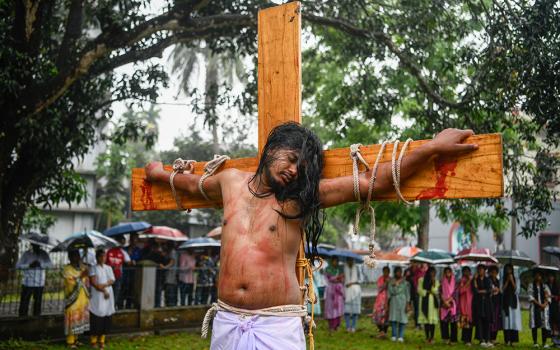In a national radio interview following his recent forced retirement, Australian Bishop William Morris of Toowoomba, Australia, raised the issue of what he said “a lot of people are calling creeping infallibility.”
In the May 8 interview, on Australia’s ABC radio network program “Sunday Nights,” Morris said that Pope Benedict XVI, in his letter demanding the bishop’s early retirement, stated, “The late Pope John Paul II has decided infallibly and irrevocably that the church has not the right to ordain women to the priesthood.”
“To my knowledge, I have never seen that written before -- using the word ‘infallible’ concerning JPII’s statement, because he never used the word ‘infallible,’ ” Morris commented.
Whether the papal treatment of Morris was fair or just is one matter -- this paper thinks it was not. The deeper question, going beyond individual persons and cases, is whether the church is experiencing what the Australian bishop and many theologians in recent decades have described as “creeping infallibility.”
At issue fundamentally is whether John Paul, in his 1994 apostolic letter, Ordinatio Sacerdotalis (“Priestly Ordination”), intended to (or actually did) lay out an infallible teaching when he said, “I declare that the church has no authority whatsoever to confer priestly ordination on women and that this judgment is to be definitively held by all the church’s faithful.”
John Paul did not formally pronounce the teaching ex cathedra (speaking from the chair of Peter) or say he was teaching infallibly in his declaration.
It is also notable that he said only that it was a “judgment” that is “to be definitively held” -- not a matter of “divine faith” that must be “believed.”
For any serious Catholic or student of Catholic teaching, the issue of the words employed in Ordinatio Sacerdotalis is not of minor import. It is one to which John Paul and Benedict -- then Cardinal Joseph Ratzinger, prefect of the Congregation for the Doctrine of the Faith -- devoted considerable energy in the 1990s.
There are two interconnected chords in the 1990s as the late John Paul and Ratzinger sought to strengthen the level of church teaching authority exercised by the pope or by the clear consensus of the world’s bishops on matters of faith or morals.
One was the doctrinal congregation’s 1998 offer of a new profession of faith and oath of fidelity for Catholic theologians and for others entering church offices. The profession introduced a new element. In addition to firm faith in the word of God and everything proposed by the church as divinely revealed, it added the declaration, “I also firmly accept and hold each and every thing definitively proposed by the church regarding teaching on faith and morals.”
That language, widely commented on by theologians and canonists at the time, was interpreted as a Vatican effort to restrict theological dissent on matters not infallibly defined but nonetheless regarded by church authorities as requiring assent -- if not of faith, at least of intellect and will.
The other chord, prefiguring the new oath of fidelity, was the doctrinal congregation’s 1995 Responsum ad Propositum Dubium (“Response to a Proposed Doubt”) concerning the level of teaching authority in the pope’s apostolic letter on the ordination of women the year before.
The response, which John Paul approved for publication, said his teaching “requires definitive assent, since, founded on the written word of God, and from the beginning constantly preserved and applied in the tradition of the church, it has been set forth infallibly by the ordinary and universal magisterium.”
That document did not place the source of infallibility in a papal judgment or decree, but in the universal teaching of all the church’s bishops. At that time there were many Catholic bishops around the world who would have regarded the ordination of women as at least possible, if not actually desirable.
And even today -- in spite of concerted Vatican efforts over the past two decades or more to stack the deck by making opposition to women’s ordination a sine qua non for promotion to the episcopacy (Jesuit Fr. Thomas J. Reese several years ago revealed a Vatican questionnaire that explicitly asked all possible episcopal nominees for their views on ordination of women) -- the universality of Catholic bishops’ opposition to ordination of women to the priesthood is at least questionable. Witness Morris’ pastoral letter that led to his dismissal.
So if Benedict said in his letter to Morris, as the Australian bishop asserts, that “the late Pope John Paul II has decided infallibly and irrevocably that the church has not the right to ordain women to the priesthood,” how did the alleged universal opinion of Catholic bishops (which is in dispute) rise in the apostolic letter to what Benedict described -- not an infallibly held universal view of the world’s bishops, but an infallibly and irrevocably taught decision by the pope himself that women cannot be ordained to the priesthood?
The doctrinal congregation can make many definitive decisions regarding church doctrine and life. It is beyond its authority to determine which church teachings are infallible and which are not. Only a pope clearly speaking ex cathedra or an ecumenical council of the world’s bishops can determine that.
“Creeping infallibility” is precisely what is at issue here -- a papal document that made no claim to infallibility raised to the level of infallibility by a Vatican congregation’s statement that has no competence to make such a determination, and now almost casually described as infallible in a disciplinary letter to a bishop by the current pope.
We rest our case on Canon Law 749.3: “No doctrine is understood as defined infallibly unless this is manifestly evident.”

